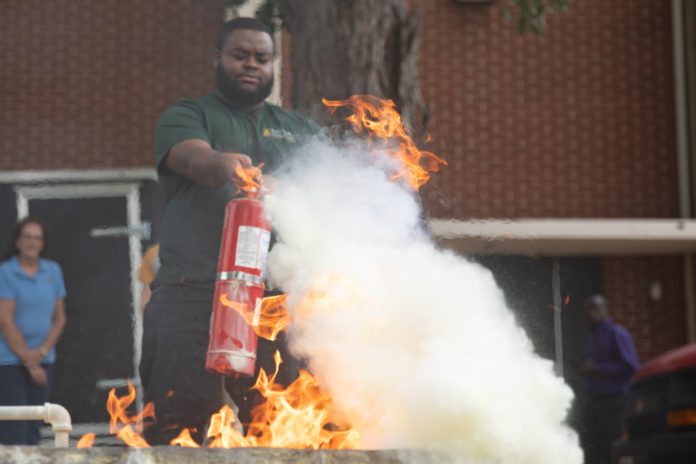
By Caroline Yablon | Reporter
Thanks to Jim Wolske, service technician with Impact Fire Services, students and faculty in scientific labs were taught how to use a fire extinguisher in case of a fire erupting on their watch. The training took place behind the McLane Student Life Center Wednesday afternoon.
Karen Humphrey, the laboratory safety program manager and radiation safety officer for the Department of Environmental Health and Safety (EHS), said students who work in labs with flammable materials are required to attend this training at least once.
Humphrey said she thinks it’s a good idea to make the training mandatory not only because it can teach a student how to put out a small fire, but also because it can prevent a bigger fire and situation from erupting.
“If it is a small fire, they can put it out and avoid causing a much bigger problem,” Humphrey said.
However, she also said safety is Baylor’s biggest priority for students, faculty and staff, so it is everyone’s responsibility to know how to put out a fire.
Wolske said a fire doubles in size every 2.5 minutes. If students and faculty know how to put out a reasonably sized fire correctly and quickly, they can will hopefully prevent the fire from expanding into a larger one, which would result in making a call to the fire department for help.
He also noted that as fire grows, it puts off hydrogen cyanide, which is a very toxic gas. He advised students to exit safely and let the fire department handle it if the fire ever becomes too much to put out with a single fire extinguisher.
“Smoke in the air is what kills you, not the fire its self,” Wolske said.
Wolske demonstrated to students how to use an A-B-C fire extinguisher, which BRK Electronics defines as: “A” TRASH–WOOD–PAPER, “B” LIQUIDS, C” ELECTRICAL EQUIPMENT — these are the materials the extinguisher can put out.
Wolske used the acronym “PASS” to illustrate how to properly use the fire extinguisher.
“P” stands for pulling the pin from the nozzle.
“A” stands for arm; he said it’s advised to stand eight feet away and arm the nozzle over the base of the fire.
“S” stands for squeezing the handle down at the fire.
The second “S” stands for sweeping the hose back and forth over the fire until it is gone.
After he explained the mechanics, each student had an opportunity to practice putting out a real fire.
Although the fire safety training was specifically for students who work in a laboratory with flammable materials, EHS does have a fire safety training coming up on Dec. 12 for those who would like to be trained on how to put out a fire.





